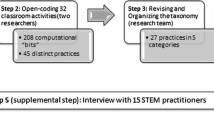Abstract
The study aimed at characterising the shift from configural reasoning to proof construction in geometry. One hundred eighty-two preservice primary teachers solved two geometry problems in which they had to generate a proof from the information provided by a geometrical configuration. Results indicated that proof construction was linked to the way pre-service teachers coordinated the different apprehensions, as identified by Duval (1995), mediated by the existence of strategic knowledge. Strategic knowledge is undertood as the ability to see some specific geometrical statements as premises of a geometrical proposition that can be used to deduce intermediate statements or the conclusion. We argue that pre-service teachers need to be aware of the connections between specific geometrical facts when they construct a proof by linking visualisation to formal reasoning. We conclude with implications for teacher education programmes.







Similar content being viewed by others
References
Arzarello, F., Olivero, F., Paola, D., & Robutti, O. (2008). The transition to formal proof in geometry. In P. Boero (Ed.), Theorems in schools: From history, epistemology and cognition to classroom practices (pp. 307–424). Rotterdam: Sense Publishers.
Battista, M. T. (2007). The development of geometric and spatial thinking. In F. Lester (Ed.), Second handbook of research on mathematics teaching and learning (Vol. 2, pp. 843–908). Charlotte: Information Age Publishing.
Chinnappan, M. (1998a). Schemas and mental models in geometry problem solving. Educational Studies in Mathematics, 36, 201–217.
Chinnappan, M. (1998b). The accessing of geometry schemas by high school students. Mathematics Education Research Journal, 10(2), 27–45.
Chinnappan, M., & Lawson, M. (2005). A framework for analysis of teachers’ geometric content knowledge and geometric knowledge for teaching. Journal of Mathematics Teacher Education, 8, 197–221. https://doi.org/10.1007/s10857-005-0852-6.
Chinnappan, M., Ekanayake, M., & Brown, C. (2012). Knowledge use in the construction of geometry proof by Sri Lankan students. International Journal of Science and Mathematics Education, 10, 865–887. https://doi.org/10.1007/s10763-011-9298-8.
Clemente, F., & Llinares, S. (2015). Formas del discurso y razonamiento configural de estudiantes para maestro en la resolución de problemas de geometría [Pre-service primary teachers’ ways of discourse and configural reasoning in solving geometrical problems]. Enseñanza de las Ciencias, 33(1), 9–27. https://doi.org/10.5565/rev/ensciencias.1332.
Clemente, F., Llinares, S., & Torregrosa, G. (2017). Visualization and Configural Reasoning. Bolema, 31(57), 497–516. https://doi.org/10.1590/1980-4415v31n57a24.
Duval, R. (1995). Geometrical pictures: Kinds of representation and specific processes. In R. Sutherland & J. Mason (Eds.), Exploiting mental imagery with computers in mathematical education (pp. 142–157). Berlin: Springer.
Duval, R. (1998). Geometry from a cognitive point of view. In C. Mammana & V. Villani (Eds.), Perspectives on the teaching of geometry for the 21st century (pp. 37–52). Dordrecht: Kluwer Academic Publishers.
Duval, R. (2007). Cognitive functioning and the understanding of mathematical processes of proof. In P. Boero (Ed.), Theorems in school. From history, epistemology and cognition to classroom practice (pp. 137–162). Rotterdam: Sense Publishers.
Fischbein, E. (1993). The theory of figural concepts. Educational Studies in Mathematics, 24, 139–162. https://doi.org/10.1007/BF01273689.
Gal, H., & Linchevski, L. (2010). To see or not to see: analyzing difficulties in geometry from the perspective of visual perception. Educational Studies in Mathematics, 74(2), 163–183. https://doi.org/10.1007/s10649-010-9232-y.
Heinze, A., Cheng, Y. H., Ufer, S., Lin, F. L., & Reiss, K. (2008). Strategies to foster students’ competencies in constructing multi-steps geometric proofs: Teaching experiments in Taiwan and Germany. ZDM: International Journal on Mathematics Education, 40(3), 443–453. https://doi.org/10.1007/s11858-008-0092-1.
Lawson, M. J., & Chinnappan, M. (1994). Generative activity during geometry problem solving: comparison of the performance of high-achieving and low-achieving high school students. Cognition and Instruction, 12(1), 61–93.
Lin, F. L., & Yang, K. (2007). The reading comprehension of geometric proofs: The contribution of knowledge and reasoning. International Journal of Science and Mathematics Education, 5, 729–754. https://doi.org/10.1007/s10763-007-9095-6.
Llinares, S., & Clemente, F. (2014). Characteristics of pre-service primary school teachers’ configural reasoning. Mathematical Thinking and Learning, 16(3), 234–250. https://doi.org/10.1080/10986065.2014.921133.
Miyazaki, M., Fujita, T., & Jones, K. (2017). Students’ understanding of the structure of deductive proof. Educational Studies in Mathematics, 94, 223–239. https://doi.org/10.1007/s10649-016-9720-9.
Nason, R., Chalmers, C., & Yeh, A. (2012). Facilitating growth in prospective teachers’ knowledge: teaching geometry in primary schools. Journal of Mathematics Teacher Education, 15(3), 227–249. https://doi.org/10.1007/s10857-012-9209-0.
Prawat, R. S. (1989). Promoting access to knowledge, strategy, and disposition in students: a research synthesis. Review of Educational Research, 59(1), 1–41.
Prusak, N., Hershkowitz, R., & Schwarz, B. (2012). From visual reasoning to logical necessity through argumentative design. Educational Studies in Mathematics, 79(1), 19–40. https://doi.org/10.1007/s10649-011-9335-0.
Stylianides, A., & Ball, D. (2008). Understanding and describing mathematical knowledge for teaching: knowledge about proof for engaging students in the activity of proving. Journal of Mathematics Teacher Education, 11(4), 307–332. https://doi.org/10.1007/s10857-008-9077-9.
Stylianides, A., Bieda, K. N., & Morselli, F. (2016). Proof and argumentation in mathematics education research. In A. Gutierrez, G. Leder, & P. Boero (Eds.), The second handbook of research on the psychology of mathematics education (pp. 315–351). Rotterdam: Sense Publishers.
Torregrosa, G., & Quesada, H. (2007). Coordinación de procesos cognitivos en Geometría [Coordination of cognitive processes in geometry]. RELIME. Revista Latinoamericana de Investigación en Matemática Educativa, 10(2), 275–300.
Torregrosa, G., Quesada, H., & Penalva, M. C. (2010). Razonamiento configural como coordinación de procesos de visualización. [Configural reasoning as coordination of visualization process]. Enseñanza de las Ciencias, 28(3), 327–340.
Weber, K. (2001). Student difficulty in constructing proofs: The need for strategic knowledge. Educational Studies in Mathematics, 48(1), 101–119. https://doi.org/10.1023/A:1015535614355.
Zazkis, R., Dubinsky, E., & Dautermann, J. (1996). Coordinating visual and analytical strategies: a study of students’ understanding of the group D4. Journal for Research in Mathematics Education, 27(4), 435–457.
Funding
The research reported here was financed in part by Spanish Ministry of Economy, Industry and Competitiveness MINECO—Spain, under Grant no. EDU2014-54526-R and EDU2017-87411-R.
Author information
Authors and Affiliations
Corresponding author
Rights and permissions
About this article
Cite this article
Llinares, S., Clemente, F. Characteristics of the shifts from configural reasoning to deductive reasoning in geometry. Math Ed Res J 31, 259–277 (2019). https://doi.org/10.1007/s13394-018-0253-7
Received:
Revised:
Accepted:
Published:
Issue Date:
DOI: https://doi.org/10.1007/s13394-018-0253-7




